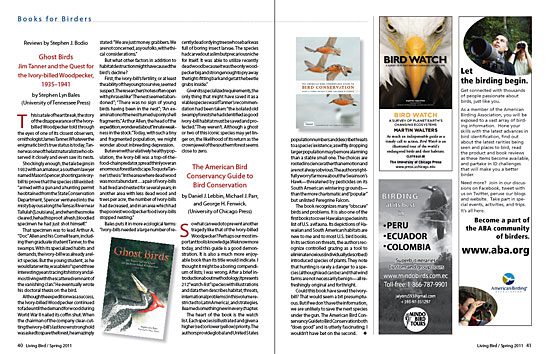Book Review: The American Bird Conservancy Guide to Bird Conservation, by Daniel Lebbin, Michael Parr, and George Fenwick
Reviewed by Stephen J. Bodio
April 15, 2011
So what can we do to prevent another tragedy like that of the Ivory-billed Woodpecker? Perhaps our most important tool is knowledge. We know more today, and this guide is a good demonstration. It is also a much more enjoyable book than its title would indicate. I thought it might be a boring compendium of lists; I was wrong. After a brief introduction about methodology, it presents 212 “watch-list” species with illustrations and data then describes habitat, threats, international problems (in this volume restricted to Latin America), and strategies. I learned something new in every chapter.
The heart of the book is the watch list. Each species is illustrated and given a higher (red) or lower (yellow) priority. The authors provide global and United States population numbers and describe threats to a species’ existence; a swiftly dropping larger population may be more alarming than a stable small one. The choices are rooted in science rather than emotion and are not always obvious. The authors rightfully worry far more about the Swainson’s Hawk—threatened by pesticides on its South American wintering grounds—than the more charismatic and “popular” but unlisted Peregrine Falcon.
The book recognizes many “obscure” birds and problems. It is also one of the first books to cover Hawaiian species in its list of U.S. avifauna. Its depictions of Hawaiian and South American habitats are new to me and to most U.S. bird books. In its section on threats, the authors recognize controlled grazing as a tool to eliminate noxious (individually described) introduced species of plants. They note that hunting is rarely a danger to a species (although lead can be) and that wind farms are not necessarily benign—all refreshingly original and forthright.
Could this book have saved the ivory-bill? That would seem a bit presumptuous. But if we don’t have the information, we are unlikely to save the next species under the gun. The American Bird Conservancy Guide to Bird Conservation both “does good” and is utterly fascinating; I wouldn’t have bet on the second.

All About Birds
is a free resource
Available for everyone,
funded by donors like you
American Kestrel by Blair Dudeck / Macaulay Library



